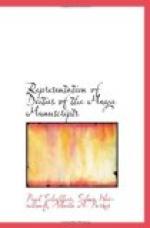F’s sign occurs once, as mentioned above, in fourfold repetition with all the four cardinal points, namely in Tro. 29*c. In ancient Central America the captured enemy was sacrificed and thus the conceptions of the war-god and of the god of death by violence and by human sacrifice are united in the figure of god F. In this character god F occurs several times in the Madrid manuscript in combat with M, the god of travelling merchants (see page 35). Spanish writers do not mention a deity of the kind described here as belonging to the Maya pantheon.
G. The Sun-God.
[Illustration: Figs. 35-36]
God G’s hieroglyph (Fig. 35) contains as its chief factor the sun-sign Kin. It is one of the signs (of which there are about 12 in the manuscripts), which has the Ben-ik prefix and doubtless denotes a month dedicated to the sun. There is, I think, no difference of opinion regarding the significance of this deity, although Fewkes, as already stated, is inclined to identify G with B, whom, it is true, the former resembles. It is surprising that a deity who from his nature must be considered as very important, is represented with such comparative infrequency. He occurs only a few times in the Dresden manuscript, for example 22b, 11c, and in the Codex Tro.-Cortesianus none can be found among the figures which could be safely regarded as the sun-god; in no manuscript except the Dresden does a deity occur wearing the sun-sign Kin on his body. But once in the Codex Cort. the figure of D appears with the sun-sign on his head, as pointed out by Fewkes in his article entitled “The God ‘D’ in the Codex Cortesianus”. G’s hieroglyph, to be sure, is found repeatedly in the Madrid manuscript, for example Codex Tro. 31c.
God G seems to be not wholly without relation to the powers of death; the owl-sign (Fig. 5) occurs once in connection with him (Dr. 11c). Besides the sun-sign Kin, which the god bears on his body, his representations are distinguished by a peculiar nose ornament (Fig. 36) which, as may be seen by comparison with other similar pictures in the Dresden manuscript, is nothing but a large and especially elaborate nose-peg. Similar ornaments are rather common just here in the carefully drawn first part of the Dresden manuscript. Compare Dr. 22b (middle figure), 21 (centre), 17b, 14a, b; occasionally they also have the shape of a flower, for example 12b (centre), 11c (left), 19a. Lastly it is worthy of note, that god G is sometimes represented with a snake-like tongue protruding from his mouth, as in Dr. 11b and c.
H. The Chicchan-God.
[Illustration: Figs. 37-40]
The figure of a deity of frequent occurrence in the Dresden manuscript is a god, who is characterized by a skin-spot or a scale of a serpent on his temple of the same shape as the hieroglyph of the day Chicchan (serpent). Moreover the representations of the god himself differ very much, so that there are almost no other positive, unvarying characteristic marks to be specified. His picture is plainly recognizable and has the Chicchan-mark on the temple in Dr. 11a, 12b and 20b.




